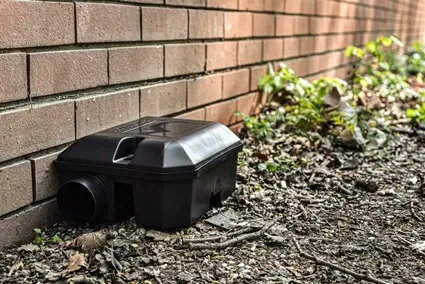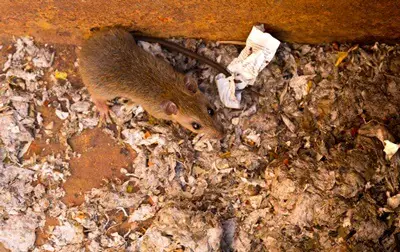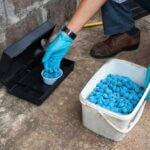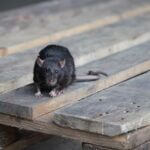It’s common for rats to build nests or travel inside walls. If poison or misfortune leads to a rat dying inside your wall, this can leave you in a difficult position.
Allowing the rat to decay will expose the home occupants to a foul smell and harmful pathogens. Getting the rat out may seem impossible, especially if it means cutting holes into your walls randomly.
However, there are efficient ways to get a rat out of walls. If you take the right precautions and know where to start, you can handle the problem safely.
How Do Rats Get Inside Walls?
According to Immunology, rats can squeeze through an opening as minor as 3/4th of an inch.
Additionally, they have flexible bodies and collapsible rib cages, which allow them to move inside constricted spaces without effort, which makes it easy for a rat to enter your walls.
In most cases, rats do so through small cracks and crevices on the surface of the wall. As buildings age, wear and tear create fissures:
- Along the foot of walls.
- At points where they connect to the ceiling.
- In corners inside and outside the building.
Rats use these as entry points. Even in the most well-maintained home, rats can enter by chewing on walls, particularly if they are made of wood or plastic air bricks.
Their strong dentition and powerful jaws make it easy for rats to chew through certain walls and gain entry into them. If all else fails, rats may burrow under walls. This is most likely if a home’s foundation is soil since rats can dig more easily here than with concrete or stone.
Regardless of the method rats use to gain entry, the outcome is the same. The rats will set up nests, as wall cavities provide a safe, quiet, and peaceful location away from humans and predators like schnauzers. They’ll reproduce quickly in this environment, especially if there’s a nearby food source.
All the rats present will cause more damage to your wall and turn your house into a haven for deadly diseases. For these reasons, take proactive steps to remove any rats from your walls.
What Does A Dead Rat in The Wall Smell Like?
If a rat dies inside your walls, it’s likely to go unnoticed until the carcass decomposes.
When the decomposition process kicks in, a dead rat’s carcass produces a putrid stench of chemical gasses like sulfur dioxide and methane. Usually, it takes about 3-5 days for a rat to start smelling.
By this time, the stench from the decaying carcass will be obvious to anyone nearby. It can be described as sickly sweet with a rancid edge.
How Long Does It Take a Rat to Decompose To A Skeleton?
It takes about 3-4 weeks for a dead rat to decompose into a skeleton.
However, the decomposition rate varies based on environmental factors, with the temperature being the most important factor. A rat will usually decompose faster in hot weather and slower in cold weather.
Think of the dead rat as you would meat purchased from the supermarket. Meat that stays in the fridge will remain fresh for longer, but if you leave it out on the counter for the night, it’ll spoil quickly.
Rats that die inside a home will decompose much slower than those that die outdoors because they’re not exposed to high environmental temperatures.
According to the Saudi Journal of Biological Sciences, the humidity level can also speed up or slow down the decomposition rate of a rat’s carcass. High humidity causes much faster decomposition since it stimulates and promotes various microbial activities in a rat’s body.
Can You Leave A Dead Rat in The Wall?
It’s never wise to leave a dead rat in the wall because the odors from the decomposing carcass will permeate your home, making your life and any others unpleasant.
The smell of decomposing matter also attracts flies and bugs that feed on dead flesh.
Most importantly, a rat’s carcass in your walls poses a serious health risk, as it’ll turn into a breeding ground for deadly pathogens.
According to the CDC, even before death, a rat can transmit illnesses through the air, such as Lassa fever, tularemia, and salmonellosis.
The young or elderly, people with respiratory issues, or those with compromised immune systems may contract illnesses that leave permanent damage or are fatal.

How To Find A Dead Rat In The Wall
Because a wall is a solid structure, it can be difficult to access the cavity where the rat has died so you can remove it. You won’t be able to visually see the rat until you’ve pulled down sections of the wall in search. This can be time-consuming to do and expensive to repair.
Instead of damaging your home unnecessarily, if you can’t find a dead rat in the house, use the smell of the rat to guide you. As bad as the odor is, it can be of assistance.
Follow the smell as best you can until you reach the epicenter of the rotting odor. Lean close to the wall and smell the area until the bad scent intensifies.
It’ll be strongest directly around the rat and should be hard to miss. The sickly-sweet odor will become fainter, and the putrid aspect will become stronger.
Prepare for Removing the Rat
Before attempting to remove the rat, put on a protective mask. This will ideally be an N95-rated Dust Mask, which is certified as adequate protection against viruses like hantavirus, which rats carry.
This will ensure you’re not unnecessarily exposed to dangerous pathogens from the rat and the new bacteria growing on its rotting carcass.
Your chosen mask should cover your mouth and nose and seal around the edges. It should be thick enough to block outside particles while allowing you to breathe. The thicker, the better.
You should also wear protective gloves, ventilate the area as best you can, and ensure no one other than necessary helpers is present. All helpers should have the same protections.
How To Get Rid Of Dead Rats In The Walls
You’ll need some materials, including the following:
- Drill
- Saw
- Garbage bag
- Flashlight
- A scoop or towel
Now you can move on to the removal process:
- Once you’ve found the rat’s location, use a drill to create a hold in the wall.
- Create three more holes in the shape of a square so that you’ve sectioned off a portion of the wall to be taken out.
- Use a saw to cut and connect the holes
- Pry the square out.
It’s wise to start with a smaller square than intended, as you may be incorrect about the precise location of the rat.
- With protection on yourself, peer in with a flashlight and look for signs of the rat.
- If you see it further out of reach, widen the hole or move down until you can access it.
- Once you have access to the rat, use gloved hands (or a towel or scoop if you are uncomfortable handling the rat) to lift the carcass out.
Lift out the rat slowly and gingerly, as advanced decomposition may leave the body unstable. You don’t want to leave pieces behind or create a hazardous mess on your floor.
- Have a plastic bag ready and immediately place the rat into it.
- Seal it, put it in another plastic bag, and seal it.
- Take it to your outside garbage can immediately.
- Dispose of your gloves in this garbage can at this point
- Immediately go to sanitize your hands and forearms.
- Once finished washing up, you can now remove your mask.
- To be safe, you may wish to change your clothing and wash them.
Follow this advice on how to dispose of a dead rat.
With the rat taken care of, you can now focus on airing out the room, deodorizing the space, sanitizing the spot where the rat decayed, and repairing the damage to your wall.
Here’s how to remove dead rat odor.







